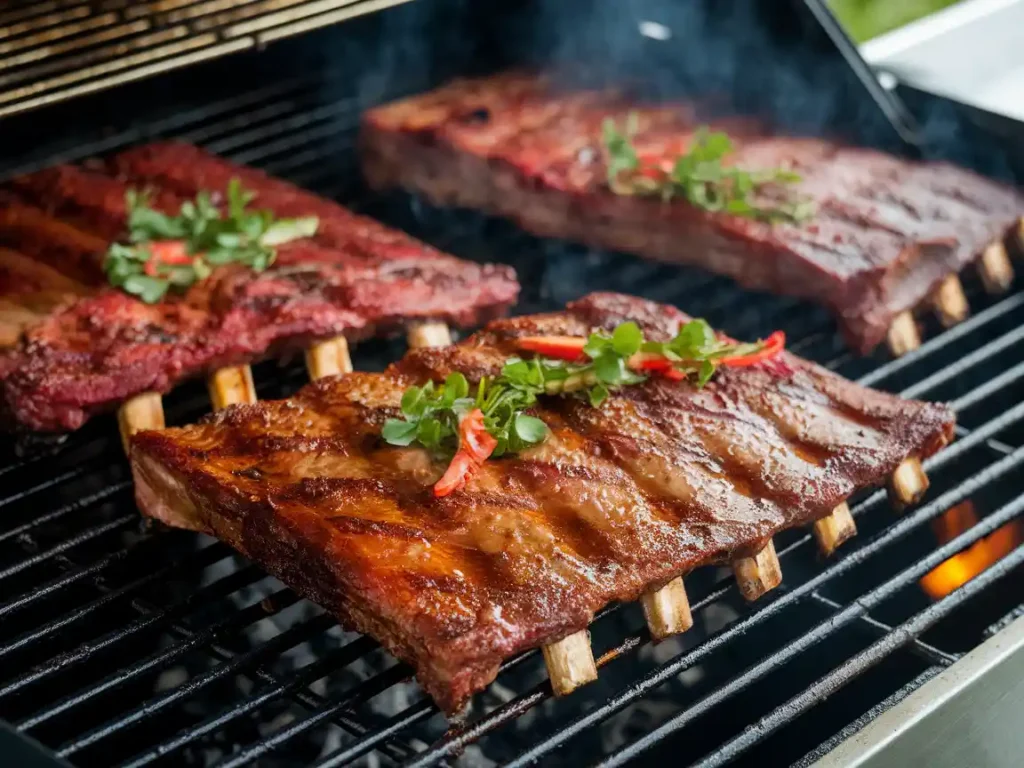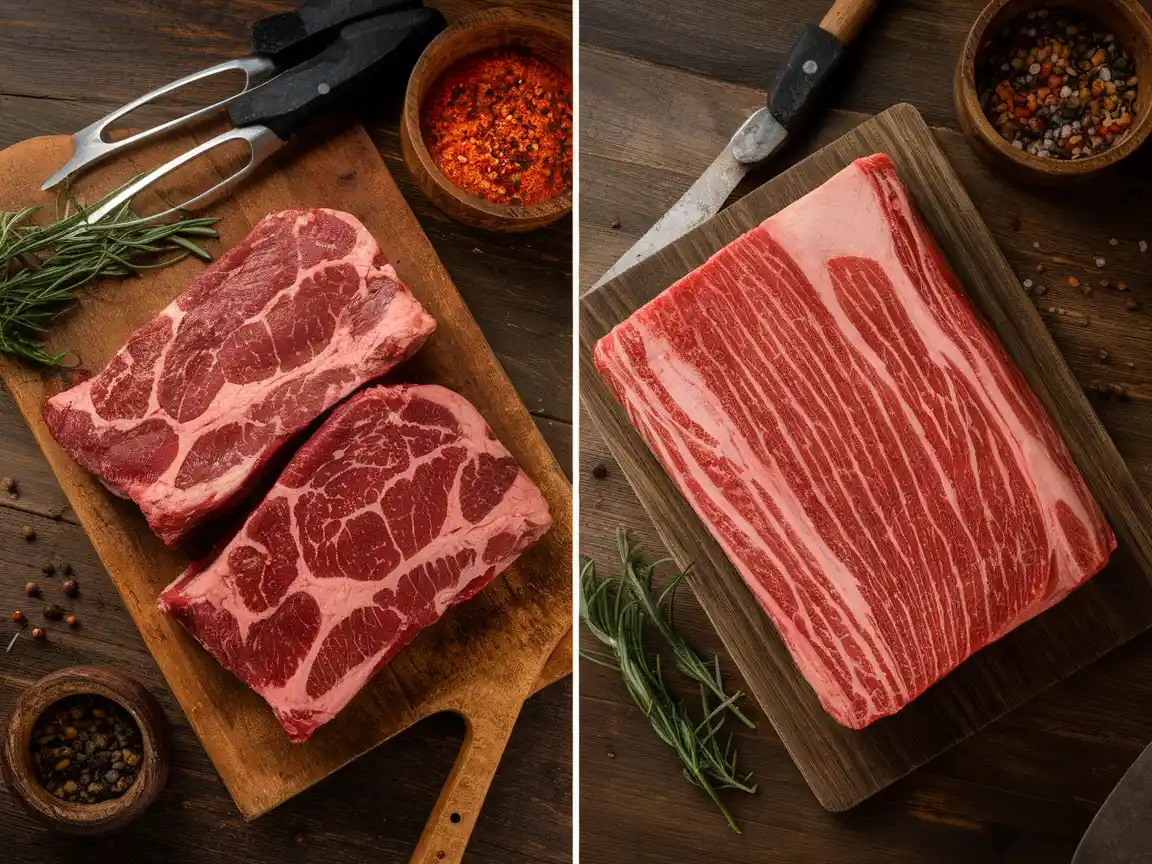Understanding the Differences Between Country-Style Beef Ribs and Short Ribs
When it comes to beef, ribs are often at the heart of some of the most mouthwatering dishes. But not all ribs are created equal. Two popular cuts—country-style beef ribs and short ribs—frequently cause confusion, even among seasoned home cooks and grill enthusiasts. While both are undeniably delicious, they are quite distinct in terms of where they come from on the cow, their flavor profiles, and the cooking techniques they pair best with. If you’ve ever wondered what sets these two apart or found yourself questioning which one to use for your next recipe, you’re in the right place.
Why the Confusion Between These Two Cuts of Beef?
Let’s get one thing straight: country-style beef ribs and short ribs are not interchangeable, but their names don’t help clarify that fact. Both are cuts of beef that play starring roles in hearty, comforting meals, yet their differences start right at the butcher’s counter. One major source of confusion is their naming. For example, despite the word “ribs,” country-style beef ribs don’t necessarily contain rib bones. On the other hand, short ribs, which do include bones, don’t always resemble what people typically picture when they think of ribs.
Additionally, the ways these cuts are packaged or prepared can add to the mix-up. A tray of country-style beef ribs might look like thick steaks, while short ribs are often pre-cut into smaller, chunkier portions. This overlap in appearance and nomenclature is why so many people get stuck scratching their heads when trying to differentiate between the two.
What Are Country-Style Beef Ribs?
Cut Location and Characteristics
Country-style beef ribs are a bit of a misnomer because they don’t actually come from the rib section of the cow. Instead, they are cut from the chuck or shoulder area, near the front of the animal. This location makes them more closely related to steaks than traditional ribs. Unlike short ribs, country-style ribs often contain less bone—or none at all. When bone is present, it’s usually a small piece of the shoulder blade rather than a rib bone.
The meat itself is typically marbled with fat, making it flavorful and rich. However, because it comes from a working muscle, it can also be tough if not cooked properly. That’s why most recipes for country-style beef ribs involve slow, moist-heat cooking methods to break down the connective tissue.
Typical Uses for Country-Style Ribs
Country-style beef ribs shine in recipes that require long, slow cooking. Braising is one of the most common methods because it allows the meat to become fall-apart tender while soaking up the flavors of the surrounding liquid. Think hearty stews, slow-cooked barbecue, or even oven-baked dishes smothered in a rich sauce. They’re also versatile enough for grilling when you’re aiming for a charred, smoky finish—though you’ll need to marinate or precook them first to ensure tenderness.
What Are Short Ribs?
Cut Location and Characteristics
Short ribs, as the name implies, do come from the rib section of the cow—but not the long, curved ribs you might imagine. Instead, short ribs are cut from the lower portion of the rib cage, near the belly. This area includes sections of the brisket, chuck, or plate. Short ribs are known for their chunky, rectangular shape, with meat sitting on top of a bone. You’ll also find “boneless short ribs,” which are essentially the same cut but with the bone removed.
Short ribs boast a generous amount of fat and connective tissue, making them ideal for slow cooking. The meat is intensely flavorful, with a rich, beefy taste that develops beautifully when cooked low and slow.
Typical Uses for Short Ribs
Short ribs are practically made for braising. Their high fat content means they become incredibly tender and juicy when simmered in liquid over several hours. Popular recipes include red wine-braised short ribs, where the meat absorbs the depth and complexity of the sauce. Short ribs are also a staple in Korean barbecue, where they’re sliced thin, marinated, and grilled to perfection. For those who love smoking meats, short ribs are an excellent choice, as their fat ensures they stay moist and flavorful even during long cooking times.
Key Differences Between Country-Style Ribs and Short Ribs
When choosing between country-style beef ribs and short ribs, it’s essential to understand their fundamental differences. These distinctions impact not only their appearance and flavor but also how they behave during cooking. Let’s break it down.
Origin on the Cow
The first major difference lies in where each cut originates. Country-style beef ribs are sourced from the chuck, which is the shoulder section of the cow. This area is home to well-exercised muscles, so the meat is firmer and requires longer cooking times to become tender.
In contrast, short ribs are cut from the lower rib section of the cow, specifically the plate, brisket, or chuck area. The meat from these areas is much fattier, leading to a richer flavor and a melt-in-your-mouth texture when cooked correctly. This distinction alone can help you decide which cut will work best for your dish.
Bone Structure and Meat Content
Here’s where things can get a little confusing. Despite the name, country-style beef ribs often have little to no bone. When they do include a bone, it’s a piece of the shoulder blade rather than a rib bone. This makes them look more like steak than traditional ribs.
Short ribs, on the other hand, are known for their characteristic bone. The bone is often rectangular or flat and runs along the bottom of the cut, with a generous layer of meat resting on top. Boneless short ribs are another option, where the rib bone is removed, leaving a thick, meat-forward cut.
Flavor and Fat Content
The flavor of these cuts also sets them apart. Country-style beef ribs are flavorful but leaner compared to short ribs. They still have some marbling, but not nearly as much as short ribs. Consequently, the flavor of country-style ribs depends heavily on seasoning, marinades, or the sauce they’re cooked in.
Short ribs, on the other hand, are prized for their rich, beefy flavor. Thanks to their higher fat content, they naturally deliver a more indulgent taste. When slow-cooked, the fat melts into the meat, creating an unforgettable depth of flavor.
Which Cut Is Meatier?
When it comes to sheer meatiness, country-style beef ribs usually take the crown. Without the large bones found in short ribs, they offer more edible meat per serving. This makes them a more economical choice when feeding a crowd.
Which Cut Is More Tender?
While both cuts can be incredibly tender if cooked properly, short ribs tend to achieve a buttery, melt-in-your-mouth texture more easily. The higher fat content and connective tissue in short ribs break down beautifully during slow cooking, making them the go-to choice for ultra-tender dishes.
Cooking Techniques for Each Cut
Choosing the right cooking method can make or break your dish. Let’s dive into how to get the best out of each cut.
How to Cook Country-Style Beef Ribs
Braising for Tenderness
Braising is a foolproof way to cook country-style beef ribs. This method involves searing the ribs to lock in flavor, then simmering them in a flavorful liquid, like beef broth or tomato-based sauce, for several hours. As the ribs cook, the liquid breaks down the tough connective tissues, resulting in fork-tender meat.
Grilling for Flavor
For those who love a good barbecue, country-style ribs can also be grilled. However, because they’re leaner than short ribs, grilling them requires extra care to avoid drying them out. Marinating the ribs beforehand and cooking them over indirect heat are essential steps for keeping them juicy.
How to Cook Short Ribs

Braising for Succulence
Short ribs are practically made for braising. Whether you’re using red wine, beef stock, or even beer, the liquid works its magic during the long cooking process. The fat in short ribs melts away, leaving behind meat that’s so tender it practically falls off the bone. Pair them with mashed potatoes or polenta for a comforting, restaurant-worthy meal.
Smoking for Depth of Flavor
For a truly unforgettable dish, try smoking short ribs. The slow cooking process allows the smoke to permeate the meat, enhancing its natural richness. The result? A deep, smoky flavor that’s perfect for barbecue lovers.
How to Choose the Right Cut for Your Recipe
Still not sure which cut to pick? It all comes down to how much time you have and the flavor you’re aiming for.
Considering Cooking Time and Methods
If you’re short on time, country-style beef ribs might be the better option. They can be grilled or roasted in less time than it takes to braise short ribs. However, if you’re planning a meal where time isn’t an issue, short ribs are worth the wait. Their slow-cooked flavor and texture are hard to beat.
Matching Flavor Profiles with Dishes
When it comes to flavor, think about the dish you’re making. For lighter, tomato-based stews or quick barbecue meals, country-style ribs are a great choice. On the other hand, if your recipe calls for rich, hearty flavors—like red wine sauces or smoky barbecue rubs—short ribs will shine.
Comparing Country-Style Beef Ribs and Short Ribs in Common Dishes
If you’re wondering how these two cuts stack up in real-world cooking scenarios, the answer depends on the recipe and cooking method. Both have their strengths and ideal uses, but their differences can significantly impact the final dish. Let’s look at how country-style beef ribs and short ribs perform in some popular recipes.
Which Cut Is Better for BBQ?
Barbecue is where many of us encounter ribs, and both cuts can shine with the right preparation. However, they bring different things to the table.
Country-style beef ribs are perfect for those who want a quicker barbecue option. Since they are often boneless or have minimal bone, they cook faster than short ribs. They work well with dry rubs or marinades and can be finished with a glaze or sauce. To get the best results, grilling over indirect heat or slow-smoking them before searing ensures they stay juicy.
Short ribs, on the other hand, are a barbecue purist’s dream. The high fat content and marbling make them ideal for low-and-slow cooking. Smoking short ribs for several hours allows the fat to render completely, resulting in tender, flavorful meat. The bones also add an extra layer of smokiness that enhances their appeal. If you’re aiming for that classic “fall-off-the-bone” rib experience, short ribs are the way to go.
Best Uses for Country-Style Ribs in Recipes
Country-style beef ribs offer versatility and convenience. Here are two standout ways to use them.
Slow-Cooker Recipes
When life gets busy, tossing country-style beef ribs into a slow cooker can save the day. A simple recipe might include beef broth, onions, garlic, and your favorite barbecue sauce. Let the ribs cook on low for 6–8 hours, and you’ll have a tender, flavorful meal with minimal effort. Serve them with mashed potatoes or coleslaw for a satisfying dinner.
Oven-Baked Dishes
For a more hands-on approach, oven-baked country-style ribs are a great choice. Coat the ribs in a spice rub or marinade, then bake them low and slow at around 325°F for 2–3 hours. Covering the baking dish with foil traps moisture, preventing the ribs from drying out. Add a barbecue glaze during the last 30 minutes of cooking for a sticky, caramelized finish.
Best Uses for Short Ribs in Recipes
Short ribs excel in rich, indulgent recipes that require long cooking times. Here are two classic ways to prepare them.
Braised Short Ribs with Red Wine
This iconic dish highlights everything wonderful about short ribs. Begin by searing the ribs in a hot pan to create a flavorful crust, then braise them in a mixture of red wine, beef stock, onions, carrots, and herbs. Simmer for 2–3 hours until the meat is tender and infused with the sauce’s depth of flavor. Serve with creamy mashed potatoes or crusty bread to soak up the juices.
Korean BBQ Short Ribs (Galbi)
If you’re looking for a bold and exciting dish, Korean BBQ short ribs, or galbi, are a must-try. These ribs are thinly sliced across the bone and marinated in a sweet-savory mixture of soy sauce, sugar, garlic, sesame oil, and ginger. Grill them quickly over high heat for a caramelized exterior and juicy interior. Pair them with steamed rice and kimchi for an authentic Korean meal.
Final Thoughts
Whether you’re planning a cozy family dinner or an impressive barbecue feast, understanding the strengths of country-style beef ribs and short ribs will help you choose the right cut for the job. Each brings something special to the table, so don’t hesitate to experiment and find your favorites.
FAQs About Country-Style Beef Ribs and Short Ribs
To round things out, here are answers to some of the most common questions about country-style beef ribs and short ribs. If you’ve ever felt stumped while shopping or cooking, these FAQs will help clear things up.
Are Country-Style Beef Ribs Boneless?
Yes, most country-style beef ribs are boneless or contain only a small piece of bone, usually from the shoulder blade. Unlike short ribs, which come from the actual rib section of the cow, country-style ribs are cut from the chuck area, making them more like thick slices of steak. Their boneless nature can make them more versatile and easier to work with in recipes.
Can Country-Style Ribs Be Substituted for Short Ribs?
In some cases, yes—but it depends on the recipe. Country-style beef ribs can work as a substitute for short ribs in dishes that don’t rely on the bone for flavor or presentation, such as stews or slow-cooked recipes. However, they are leaner and less rich, so the end result may taste different. For recipes where the bone plays a key role, like braised short ribs, it’s best to stick with the original cut.
Which Cut Is More Affordable?
Country-style beef ribs are typically more affordable than short ribs. This is partly due to their leaner composition and the fact that they come from the chuck, a less expensive part of the cow. Short ribs, with their higher fat content and bone-in presentation, tend to cost more per pound. If you’re cooking for a crowd on a budget, country-style ribs might be the better choice.
Do Country-Style Ribs Taste Like Short Ribs?
Not exactly. While both cuts are flavorful, short ribs have a richer, more intense taste due to their higher fat content and marbling. Country-style ribs, on the other hand, are leaner and have a beefy flavor that depends heavily on seasonings or the cooking method. If you love bold, indulgent flavors, short ribs are the way to go, while country-style ribs offer a lighter alternative.
Why Do Country-Style Ribs Look Like Pork Ribs?
This confusion arises because of their shape and the way they’re cut. Country-style beef ribs are long and thick, similar in appearance to pork ribs, especially when they have a bit of bone attached. Additionally, grocery stores sometimes display them near pork ribs, which adds to the mix-up. Always double-check the label to ensure you’re buying beef if that’s what you’re after.
How Can You Tell the Difference Between These Cuts at the Store?
The easiest way to tell them apart is by looking at the bone structure and packaging. Short ribs are chunkier and include a section of rib bone, while country-style ribs are usually boneless or have a small blade bone. The labels should also specify the cut, but when in doubt, asking the butcher is your best bet.
What’s the Best Way to Serve Each Type of Rib?
Country-style beef ribs are best served with hearty sides like mashed potatoes, roasted vegetables, or coleslaw. They’re versatile enough for casual weeknight dinners or backyard barbecues. Meanwhile, short ribs are ideal for more indulgent meals, often paired with creamy polenta, buttered noodles, or crusty bread to soak up the rich sauce. For a gourmet touch, garnish braised short ribs with fresh herbs like parsley or thyme.
Wrapping It Up
Whether you’re a seasoned pitmaster or a home cook exploring new recipes, understanding the nuances between country-style beef ribs and short ribs is key to creating dishes that wow. From their origins on the cow to their ideal cooking methods, each cut offers unique benefits that cater to different tastes and occasions. Armed with this knowledge, you’re ready to make confident choices at the butcher counter and serve up ribs that everyone will love.

